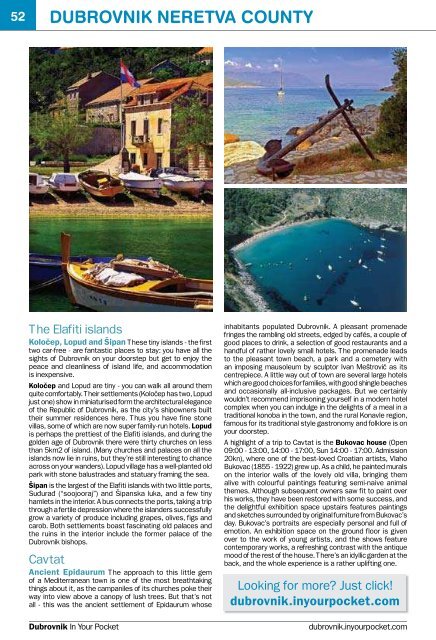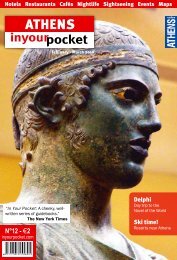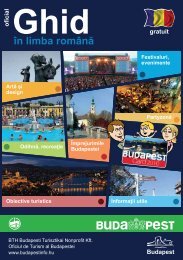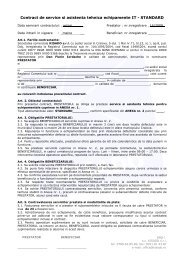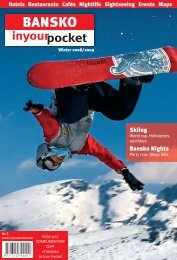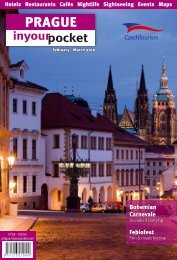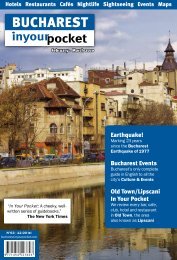DUBROVNIK - KISADO
DUBROVNIK - KISADO
DUBROVNIK - KISADO
You also want an ePaper? Increase the reach of your titles
YUMPU automatically turns print PDFs into web optimized ePapers that Google loves.
52 dubrovnik neretva county<br />
dubrovnik neretva county<br />
53<br />
Konavle<br />
The Konavle region stretches from Cavtat to the border with<br />
Montenegro. The village of Čilipi close to the airport is one<br />
of the cultural centres of Konavle, and on Sunday mornings<br />
(during summer) you can witness the traditional songs and<br />
dances of Konavle and performers dressed in colourful folk<br />
costume. Konavle consists of a fertile valley plus upland<br />
and coastal parts, all with stone villages that would reduce<br />
real estate agents to tears. In the central valley, you’ll find<br />
traditional rural restaurants where you can enjoy delicious<br />
home grown food - locally reared meat and trout, sometimes<br />
served by waiters and waitresses in traditional costume<br />
(see our “Where to eat” pages). If you come in spring, you<br />
can try dishes made with wild asparagus and see almond<br />
orchards in bloom.<br />
The upland section borders with Herzegovina, for centuries<br />
the dividing line with the Ottoman Empire. Its highest point<br />
is the Snježnica (“snowy”) peak, 1234m high. The village<br />
cemetery at Brotnice has unusual gravestones (stećci) of the<br />
Bogomil sect, featuring vivid primitive carvings and lettering<br />
in the ancient language of Bosnia. There are well-marked<br />
hiking trails, and organised trips include a hearty meal as<br />
part of the deal.<br />
The coastal part of Konavle is unusual for Croatia in that<br />
it is characterised by limestone cliffs. There are very few<br />
settlements, and the only people on the shores are locals<br />
looking for a little solitude. At the village of Močići there is<br />
a second century stone carving of the pagan god Mitreus,<br />
and scattered around are old houses with unusual conical<br />
chimneys. Molunat, the largest coastal settlement, is a quiet<br />
fishing village in a pretty cove.<br />
The Prevlaka peninsula is the southernmost point of Croatia<br />
and there’s now a Nature Park here, from which you have<br />
views over the Gulf of Kotor in Montenegro, with wild mountain<br />
ranges behind. Prevlaka was until recently a military zone,<br />
so don’t be surprised to come across barracks now used<br />
as a realistic venue for paintball games. Military enthusiasts<br />
will also be interested to see the islet which used to be an<br />
Italian prison in WWII. There is a strange Cyrillic-inscribed<br />
monument within the Park, apparently containing the bones<br />
of prisoners who died of hunger – no mention is made of this<br />
in the pamphlet. More cheerfully, there’s also a petting zoo,<br />
an excellent climbing wall, mountain bikes are for hire and you<br />
can feast on grilled meat and have a dip.<br />
Agrotourism<br />
Konoba Vinica - Monković family Pridvorje,<br />
Ljuta, tel. 79 12 44/ 098 34 54 59, monkovic@<br />
konobavinica.com, www.konobavinica.com. Another<br />
excellent option in the Konavle region south of Cavtat.<br />
If you ask nicely, the Monković family who run the place<br />
may show you their collection of folk costumes as you<br />
digest your home made prosciutto, cheese, roast meat,<br />
trout and garden salad. A drop of home made rakija would<br />
go down a treat too… QOpen 12:00 - 24:00. Closed<br />
Mon. Closed December 24 - January 31. (50 - 110kn).<br />
PALB<br />
The Elafiti islands<br />
Koločep, Lopud and Šipan These tiny islands - the first<br />
two car-free - are fantastic places to stay: you have all the<br />
sights of Dubrovnik on your doorstep but get to enjoy the<br />
peace and cleanliness of island life, and accommodation<br />
is inexpensive.<br />
Koločep and Lopud are tiny - you can walk all around them<br />
quite comfortably. Their settlements (Koločep has two, Lopud<br />
just one) show in miniaturised form the architectural elegance<br />
of the Republic of Dubrovnik, as the city’s shipowners built<br />
their summer residences here. Thus you have fine stone<br />
villas, some of which are now super family-run hotels. Lopud<br />
is perhaps the prettiest of the Elafiti islands, and during the<br />
golden age of Dubrovnik there were thirty churches on less<br />
than 5km2 of island. (Many churches and palaces on all the<br />
islands now lie in ruins, but they’re still interesting to chance<br />
across on your wanders). Lopud village has a well-planted old<br />
park with stone balustrades and statuary framing the sea.<br />
Šipan is the largest of the Elafiti islands with two little ports,<br />
Suđurađ (“soojooraj”) and Šipanska luka, and a few tiny<br />
hamlets in the interior. A bus connects the ports, taking a trip<br />
through a fertile depression where the islanders successfully<br />
grow a variety of produce including grapes, olives, figs and<br />
carob. Both settlements boast fascinating old palaces and<br />
the ruins in the interior include the former palace of the<br />
Dubrovnik bishops.<br />
Cavtat<br />
Ancient Epidaurum The approach to this little gem<br />
of a Mediterranean town is one of the most breathtaking<br />
things about it, as the campaniles of its churches poke their<br />
way into view above a canopy of lush trees. But that’s not<br />
all - this was the ancient settlement of Epidaurum whose<br />
inhabitants populated Dubrovnik. A pleasant promenade<br />
fringes the rambling old streets, edged by cafés, a couple of<br />
good places to drink, a selection of good restaurants and a<br />
handful of rather lovely small hotels. The promenade leads<br />
to the pleasant town beach, a park and a cemetery with<br />
an imposing mausoleum by sculptor Ivan Meštrović as its<br />
centrepiece. A little way out of town are several large hotels<br />
which are good choices for families, with good shingle beaches<br />
and occasionally all-inclusive packages. But we certainly<br />
wouldn’t recommend imprisoning yourself in a modern hotel<br />
complex when you can indulge in the delights of a meal in a<br />
traditional konoba in the town, and the rural Konavle region,<br />
famous for its traditional style gastronomy and folklore is on<br />
your doorstep.<br />
A highlight of a trip to Cavtat is the Bukovac house (Open<br />
09:00 - 13:00, 14:00 - 17:00, Sun 14:00 - 17:00. Admission<br />
20kn), where one of the best-loved Croatian artists, Vlaho<br />
Bukovac (1855 - 1922) grew up. As a child, he painted murals<br />
on the interior walls of the lovely old villa, bringing them<br />
alive with colourful paintings featuring semi-naive animal<br />
themes. Although subsequent owners saw fit to paint over<br />
his works, they have been restored with some success, and<br />
the delightful exhibition space upstairs features paintings<br />
and sketches surrounded by original furniture from Bukovac’s<br />
day. Bukovac’s portraits are especially personal and full of<br />
emotion. An exhibition space on the ground floor is given<br />
over to the work of young artists, and the shows feature<br />
contemporary works, a refreshing contrast with the antique<br />
mood of the rest of the house. There’s an idyllic garden at the<br />
back, and the whole experience is a rather uplifting one.<br />
Looking for more? Just click!<br />
dubrovnik.inyourpocket.com<br />
www.inyourpocket.com<br />
Dubrovnik In Your Pocket<br />
dubrovnik.inyourpocket.com<br />
dubrovnik.inyourpocket.com<br />
Winter 2009 - Spring 2010


